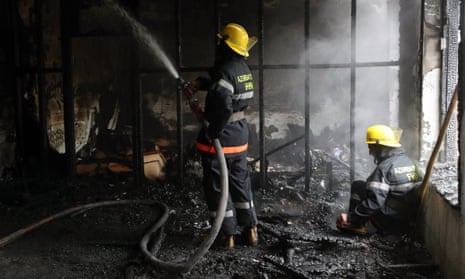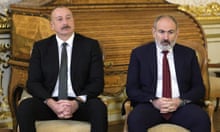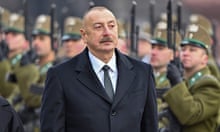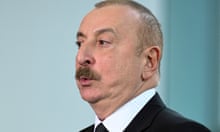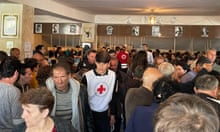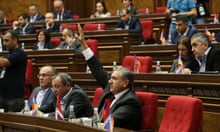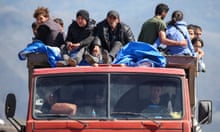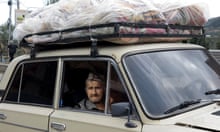Armenian and Azerbaijani forces have accused each other of shelling cities in a dangerous escalation of the eight-day war in the south Caucasus that it is feared could lead to mass civilian casualties.
Separatist forces in Nagorno-Karabakh – an ethnic Armenian enclave that broke away from Azerbaijan in the 1990s – have reported continuous heavy artillery fire on their capital, Stepanakert, since Friday. It reported an unspecified number of civilian casualties and said eight soldiers had been injured.
Azerbaijan’s defence ministry said Armenian forces were shelling three of its towns on Monday, after hitting the country’s second-largest city, Ganja, the day before in what Nagorno-Karabakh’s leader said was an act of retaliation and a “warning” against targeting civilian settlements in the breakaway region. Baku said one person had been killed and four injured in the attack on Ganja.
Firefights of varying intensity “continue to rage” elsewhere in the conflict zone, Armenian defence ministry spokeswoman Shushan Stepanyan said on Facebook.
Fighting between Azerbaijani and Armenian forces – comprising Nagorno-Karabakh fighters and soldiers from the Republic of Armenia – erupted on 27 September after months of growing tensions over the territory, which is criss-crossed by vital energy pipelines and has strategic value to Russia, Turkey and Iran.
The separatists’ foreign ministry said on Monday that shelling of Stepanakert had resumed at 6.30am (0230 GMT), with four shells hitting the city. Residents had spent the weekend cramming into underground shelters and many are leaving.
It released video footage of repeated bursts of heavy shelling and debris from seriously damaged blocks of flats, claiming Azerbaijan had used cluster munitions, which are banned by international humanitarian law.
Amnesty International said on Monday it had corroborated the use of an Israeli-made cluster munition in residential areas in Stepanakert.
Residents told the Russian state RIA Novosti news agency that parts of the city were suffering shortages of electricity and gas after the strikes.
The Armenian prime minister, Nikol Pashinyan, said that while Nagorno-Karabakh’s army “confidently controls the situation” in some areas where fighting is going on, it is “very difficult” in other areas.
Azerbaijan said Armenian forces were shelling “densely populated civilian areas” in Ganja, Barda, Beylagan and other towns “with missiles and rockets.”
Armenia’s foreign ministry dismissed allegations of attacks being launched from Armenia’s territory as a “disinformation campaign” by Azerbaijan.
Nagorno-Karabakh officials have said nearly 200 servicemen on their side have died in the clashes since then. Eighteen civilians have been killed and more than 90 others wounded. Azerbaijani authorities have not given details about military casualties, but said 24 civilians were killed and 124 others were wounded.
The International Committee of the Red Cross has condemned the reports of “indiscriminate shelling and other alleged unlawful attacks using explosive weaponry in cities, towns and other populated areas”.
Civilians huddled in the basement of Stepanakert’s stone-walled Holy Mother of God Cathedral on Sunday, seeking refuge as explosions and air raid warnings sounded.
Azerbaijan said two civilians had been killed in shelling on the southern town of Beylagan, where residents were picking through the rubble of destroyed homes.
Each side accused the other of targeting civilian areas. In a fiery address to the nation on Sunday, the Azerbaijani president, Ilham Aliyev, set conditions for a halt to the fighting that would be almost impossible for Armenia to accept.
He said Armenian forces “must leave our territories, not in words but in deeds”, provide a timetable for a full withdrawal, apologise to the Azerbaijani people and recognise the territorial integrity of Azerbaijan.
Yerevan rejected Aliyev’s demands, while Karabakh’s presidency threatened to “expand subsequent [military] actions to the entire territory of Azerbaijan”.
Russia, the US and France – the co-chairs of a mediation group that has failed to find a political resolution to the conflict – have called for an immediate halt to the fighting.
The Russian foreign minister, Sergei Lavrov, expressed concern over “the increase of casualties” among civilians in a call with his Armenian counterpart on Sunday.
Karabakh’s declaration of independence from Azerbaijan during the collapse of the Soviet Union sparked a war in the early 1990s that killed 30,000 people.
Talks to resolve the conflict have made little progress since a 1994 ceasefire agreement.
The foreign ministry in Iran, which has nearly 470 miles (760km) of border with Azerbaijan and a short border with Armenia, said it is working on a peace plan.
A spokesman Saeed Khatibzadeh did not elaborate but said it was talking to all related parties.
“Iran has prepared a plan with a specific framework containing details after consultations with both sides of the dispute, Azerbaijan and Armenia, as well as regional states and neighbours, and will pursue this plan,” he said.
Khatibzadeh also warned both sides against expanding the hostilities into Iranian territory.
“Any aggression against the borders of the Islamic Republic, even inadvertently, is a very serious red line for the Islamic Republic that should not be crossed,” he said.
Since the beginning of the conflict, stray mortar shells have injured a child and damaged some buildings in rural areas in northern Iran, near the border with Azerbaijan.
